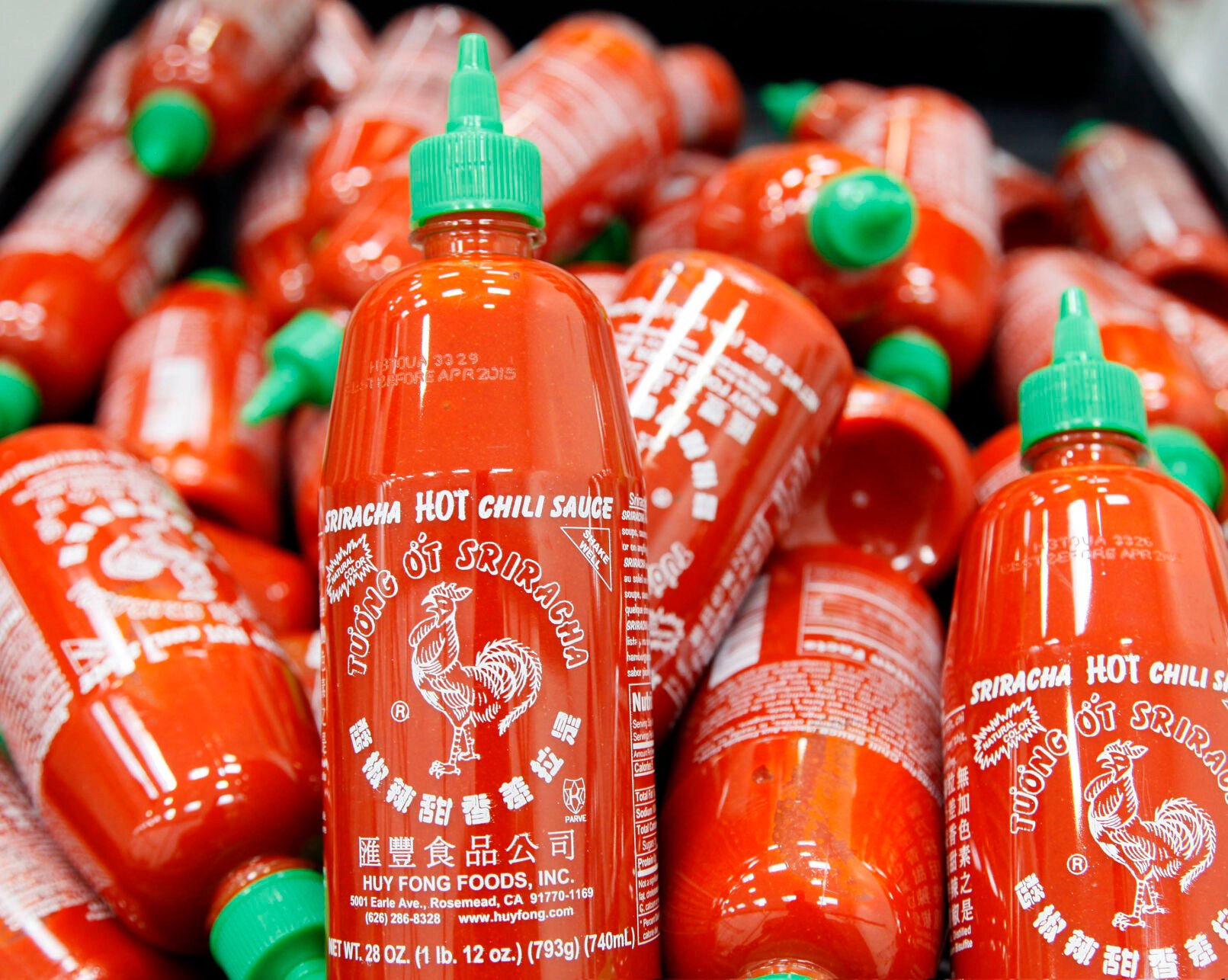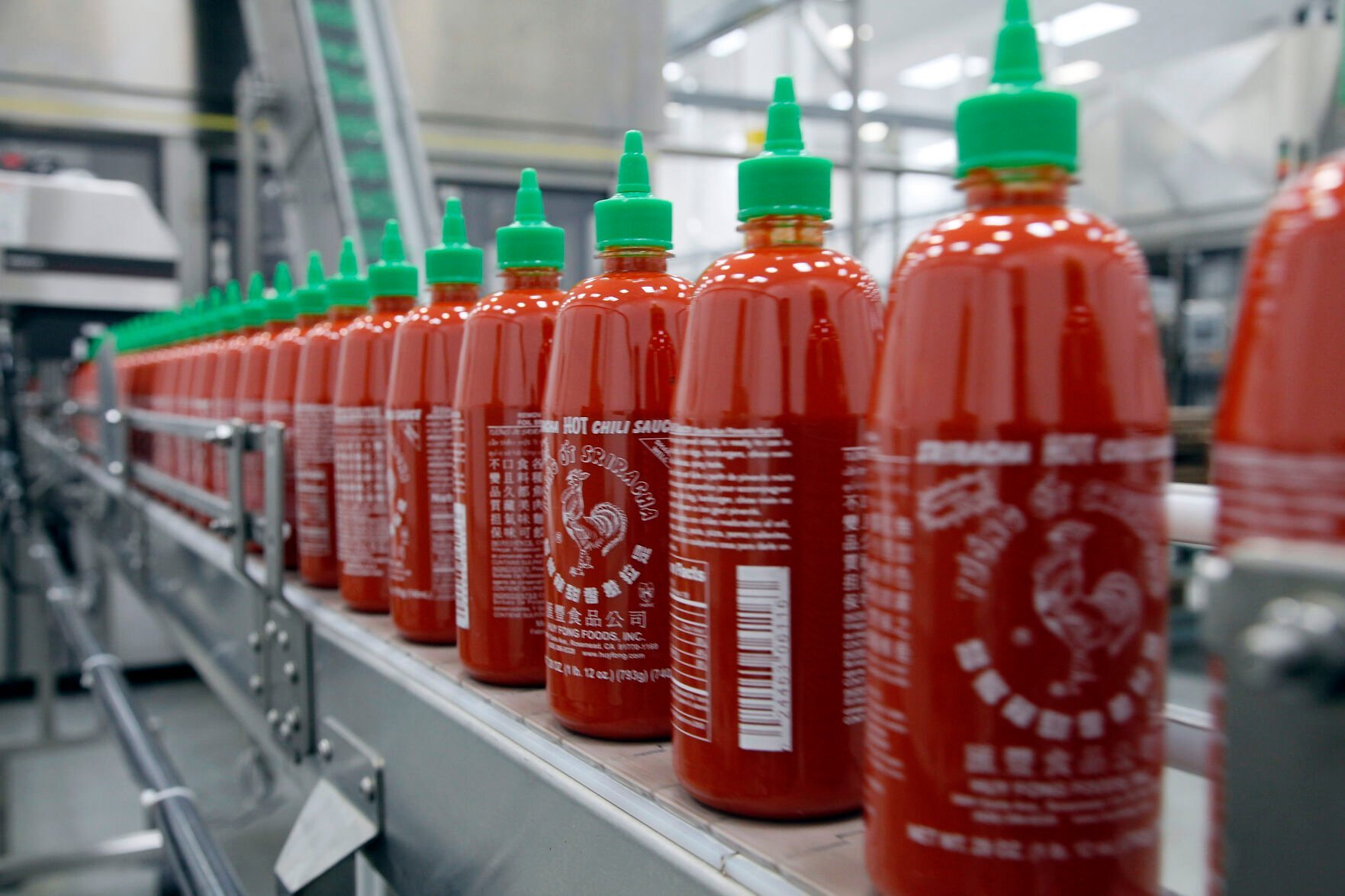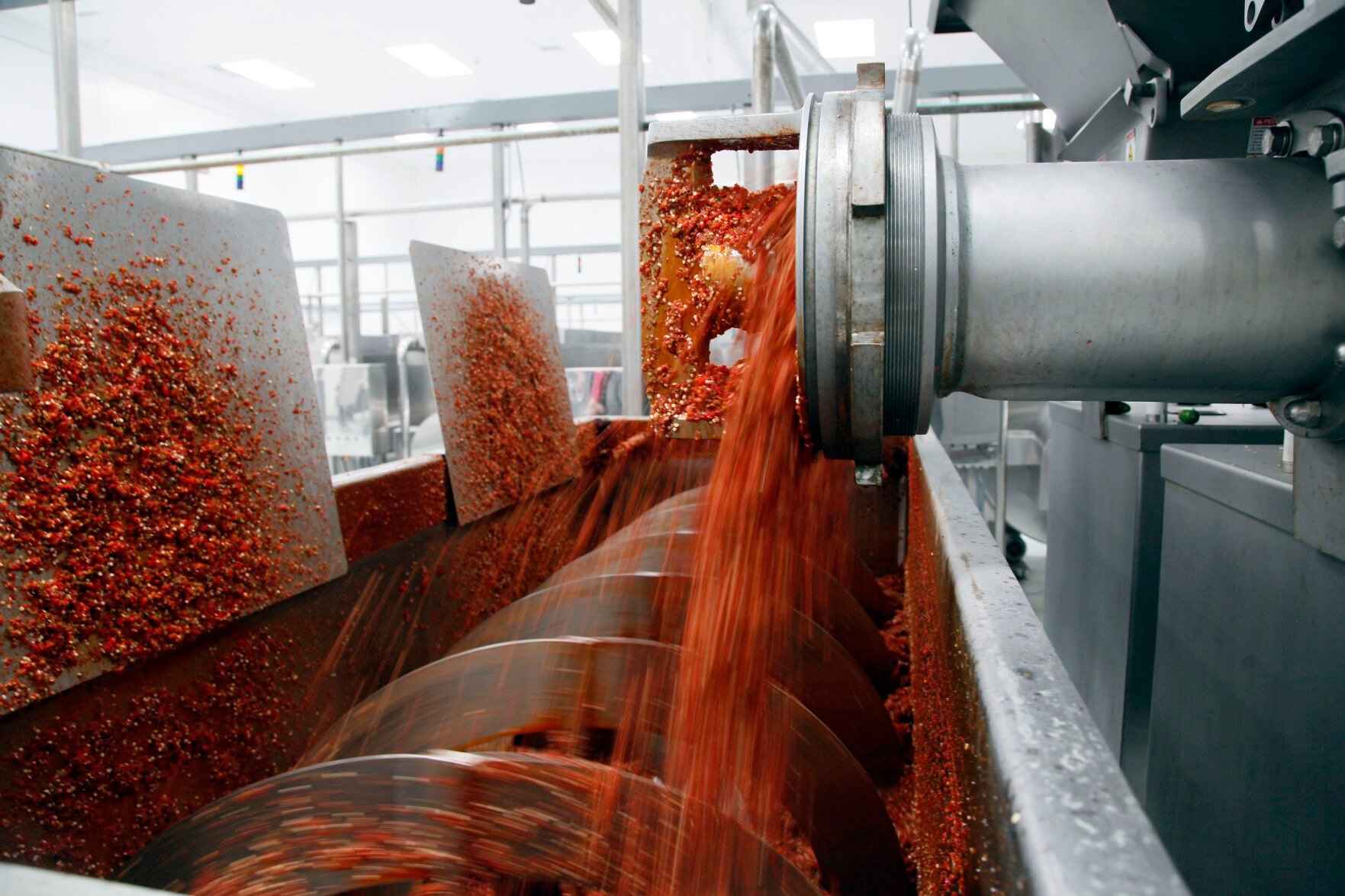NEW YORK — It’s not just you. Sriracha is hard to come by these days — at least for one popular brand.
The shortage of Huy Fong Foods’ Sriracha, the beloved red hot sauce packaged in those green-capped bottles, isn’t new — with the company pointing to a scarcity of chile pepper supply for several years now. And as frustrated fans continue to face store shelves missing the Huy Fong name, third-party resellers are punching up prices.
Huy Fong Sriracha, which used to go for under $5 or $10 a bottle, is now selling for shocking amounts in some listings posted to sites with vast third-party marketplaces — including Amazon, eBay and Walmart. Many are simply sold out.

Nick Ut, Associated Press
Huy Fong Sriracha, which used to go for under $5 or $10 a bottle, is now selling for shocking amounts on some third-party marketplaces as shortages of raw materials beset the maker of the beloved sauce.
For those still in stock, prices range depending where you look. Ads for a single 17-ounce bottle on eBay this week stretched from around $20 to a whopping $150 — contrasting significantly from the price tags of other hot sauce brands, who don’t appear to have the same level of supply troubles.
Huy Fong said it continues to be beset by shortages of raw materials, echoing a similar scarcity last year when the company temporarily suspended sales of Sriracha and other popular products like Chili Garlic and Sambal Oelek.
Huy Fong said Wednesday that “limited production” resumed recently, although the California company didn’t specify by how much or provide an estimate of when it believes suppliers will be able to deliver an adequate number of peppers.
“Because we do not sell directly to retail/market levels, we cannot determine when the product will hit shelves again and/or who currently has the product in stock,” Huy Fong said in a statement.
Here’s what you need to know:
Why is there a Huy Fong Sriracha shortage?
Experts say Huy Fong’s shortage is partially a consequence of climate change — pointing to weather shifts and extreme drought in Mexico and the U.S. Southwest, where Huy Fong sources all of its chile peppers.
“The main culprit here is a shortage of their primary ingredient, the red jalapeño chile pepper,” said David Ortega, a food economist and associate professor at Michigan State University. “And that’s due to climate change and the mega drought.”
These peppers are typically grown under irrigation, with a lot of water drawn from the Colorado River — which has reached unprecedented low levels over recent years, Ortega said. The region has suffered insufficient rainfall and reduced run-off from snowpack.

Nick Ut, Associated Press
Huy Fong's troubles with chile supply aren't new, and experts say the shortage is partially a consequence of climate change.
Huy Fong’s troubles with chile supply aren’t new. When the company suspended sales last year, it pointed to a 2020 email warning of a chile pepper shortage, noting that a lack of supply had become more severe due to recent weather conditions.
But while climate change continues to have signifcant impacts on agriculture as a whole, it’s “not whole story” for the current Huy Fong Sriracha shortage, extension vegetable specialist and professor at New Mexico State University Stephanie Walker said. She speculates that Huy Fong may not have enough suppliers with different farmers — and could be looking to build relationships with new growers.
Prices skyrocket from resellers
The erosion of available supplies has rocked the prices of Huy Fong Sriracha that is still available. In many places, the bottles are simply sold out — giving leverage to resellers listing the now hard-to-find and highly sought-after product.
Another market force at play is consumer behavior: in this case, hoarding. The panic around potentially losing access to a desired product leads many people to buy more than they would typically need, — much like what was seen with toilet paper at the beginning of the COVID-19 pandemic.
Where does Huy Fong get its chile peppers?
Huy Fong, which was founded decades ago by David Tran, currently sources its chile peppers from various farms in California, New Mexico and Mexico.

Nick Ut, Associated Press
Sriracha chili sauce is produced Oct 29, 2013, at the Huy Fong Foods factory in Irwindale, Calif. Huy Fong, which was founded decades ago by David Tran, currently sources its chile peppers from various farms in California, New Mexico and Mexico.
Before sourcing from these farms, California-based Underwood Ranches was Huy Fong’s sole supplier for nearly 30 years. The partnership collapsed in 2017 following a financial dispute. Two years later, a jury determined that Huy Fong breached its contract with Underwood Ranches and also committed fraud — awarding Underwood $23.3 million.
Underwood Ranches, which sells its own Sriracha sauce, has not had trouble getting jalapeños from Mexico, owner Craig Underwood told The New York Times this week — while also pointing to “huge demand for our product from Huy Fong’s former customers.” The Associated Press reached out to Underwood for further comment on Thursday.
Are other hot sauces facing shortages?
There’s a myriad of hot sauces, including other of Sriracha-style products, that remain easy to find at reasonable prices. Tabasco, for example, has created a page dedicated to helping customers find nearby stores that sell its brand of Sriracha.
There’s a few possible explanations for this, experts say. Again, some speculate that Huy Fong may issues with its current chile suppliers. Other brands could also use different pepper variants and source from farms that haven’t been hit as hard. Some might also be in a position to tinker with recipes — but perfecting sauces take a long time, as would finding a new variant, experts say.
“Growing the crop in an area less affected by extreme weather or breeding new variants of the peppers that are more tolerant to heat and require less water, if possible, at all, would take years,” Richard Howells, a supply chain expert at SAP, wrote in a blog post earlier this week.
Experts also underline that climate change will impact produce and food across the board, not just chile peppers.
“We saw the price of lettuce skyrocket earlier this year, again as a result of these extreme temperatures and related factors like the spread of disease (in plants),” Ortega said. “I would not be surprised to learn about other product shortages that are due to failed crops or just a significant decrease in production because of climate change.”
-
Got Sriracha? The price for a bottle of Huy Fong’s iconic hot sauce gets spicy with supplies short
Abel Uribe/Chicago Tribune/Shannon Kinsella/food styling/TNS
Type: Louisiana-style hot sauce.
Ingredients: Distilled vinegar, tabasco chiles, salt.
Edmund McIlhenny founded this classic American hot sauce company back in 1868. Unlike most Louisiana-style hot sauces that use cayenne chiles, Tabasco uses tabasco chiles. These are mixed with salt and vinegar before being aged in oak barrels for “up to three years,” according to their website. We were surprised by how much spicier Tabasco was than its competitors. It has an official count of 2,500 to 5,000 Scoville heat units. The thin sauce has a heat that lingers on the tongue for a long time. We also picked up on a slightly smoky background. Tabasco only has 35 milligrams of salt per teaspoon, which is the second least of the sample group.
Abel Uribe/Chicago Tribune/Shannon Kinsella/food styling/TNS
Type: Louisiana-style hot sauce.
Ingredients: Distilled vinegar, tabasco chiles, salt.
Edmund McIlhenny founded this classic American hot sauce company back in 1868. Unlike most Louisiana-style hot sauces that use cayenne chiles, Tabasco uses tabasco chiles. These are mixed with salt and vinegar before being aged in oak barrels for “up to three years,” according to their website. We were surprised by how much spicier Tabasco was than its competitors. It has an official count of 2,500 to 5,000 Scoville heat units. The thin sauce has a heat that lingers on the tongue for a long time. We also picked up on a slightly smoky background. Tabasco only has 35 milligrams of salt per teaspoon, which is the second least of the sample group.
-
Got Sriracha? The price for a bottle of Huy Fong’s iconic hot sauce gets spicy with supplies short
Abel Abel Uribe/Chicago Tribune/Shannon Kinsella/food styling/TNS
Type: Louisiana-style hot sauce.
Ingredients: Aged cayenne peppers, vinegar, salt.
First created in 1928, “Louisiana” Hot Sauce is much milder than Tabasco, with a heat that pops up for a second before dissipating. But it has a strong initial rush of flavor thanks to a lot of salt. In fact, at 200 milligrams per teaspoon, it takes the prize as the saltiest hot sauce we sampled. If you pour it on something very bland, “Louisiana” Hot Sauce could add a lot of flavor. But if the dish is already salty, it might be overkill.
Abel Abel Uribe/Chicago Tribune/Shannon Kinsella/food styling/TNS
Type: Louisiana-style hot sauce.
Ingredients: Aged cayenne peppers, vinegar, salt.
First created in 1928, “Louisiana” Hot Sauce is much milder than Tabasco, with a heat that pops up for a second before dissipating. But it has a strong initial rush of flavor thanks to a lot of salt. In fact, at 200 milligrams per teaspoon, it takes the prize as the saltiest hot sauce we sampled. If you pour it on something very bland, “Louisiana” Hot Sauce could add a lot of flavor. But if the dish is already salty, it might be overkill.
-
-
Got Sriracha? The price for a bottle of Huy Fong’s iconic hot sauce gets spicy with supplies short
Abel Uribe/Chicago Tribune/Shannon Kinsella/food styling/TNS
Type: Louisiana-style hot sauce.
Ingredients: Aged cayenne chiles, distilled vinegar, water, salt and garlic powder.
Frank’s Redhot originated in 1920 in Louisiana, but it’s probably best known as the base of the original Buffalo wings recipe from the Anchor Bar in Buffalo, New York. It has a stronger vinegar kick than Louisiana, and seems slightly milder even though several websites claim that the Scoville rating is about the same. This is probably due to the addition of garlic powder, which provides a rounder, sweeter base. It’s easy to see why this sauce plays so well with chicken wings.
Abel Uribe/Chicago Tribune/Shannon Kinsella/food styling/TNS
Type: Louisiana-style hot sauce.
Ingredients: Aged cayenne chiles, distilled vinegar, water, salt and garlic powder.
Frank’s Redhot originated in 1920 in Louisiana, but it’s probably best known as the base of the original Buffalo wings recipe from the Anchor Bar in Buffalo, New York. It has a stronger vinegar kick than Louisiana, and seems slightly milder even though several websites claim that the Scoville rating is about the same. This is probably due to the addition of garlic powder, which provides a rounder, sweeter base. It’s easy to see why this sauce plays so well with chicken wings.
-
Got Sriracha? The price for a bottle of Huy Fong’s iconic hot sauce gets spicy with supplies short
Abel Uribe/Chicago Tribune/Shannon Kinsella/food styling/TNS
Type: Louisiana-style hot sauce.
Ingredients: Aged cayenne chiles, distilled vinegar, salt.
Because it uses cayenne chiles, Crystal Hot Sauce has a flavor profile close to Louisiana, albeit with a much bigger cayenne kick. The heat lingers confidently on your tongue for quite a while. Crystal also has a more prominent dark chile flavor, and a slightly subdued vinegar profile compared to Tabasco. This can oddly make it seem less spicy at first, before the chile heat begins its ascent.
Abel Uribe/Chicago Tribune/Shannon Kinsella/food styling/TNS
Type: Louisiana-style hot sauce.
Ingredients: Aged cayenne chiles, distilled vinegar, salt.
Because it uses cayenne chiles, Crystal Hot Sauce has a flavor profile close to Louisiana, albeit with a much bigger cayenne kick. The heat lingers confidently on your tongue for quite a while. Crystal also has a more prominent dark chile flavor, and a slightly subdued vinegar profile compared to Tabasco. This can oddly make it seem less spicy at first, before the chile heat begins its ascent.
-
-
Got Sriracha? The price for a bottle of Huy Fong’s iconic hot sauce gets spicy with supplies short
Abel Uribe/Chicago Tribune/Shannon Kinsella/food styling/TNS
Type: Mexican-style hot sauce.
Ingredients: water, puya chiles, vinegar, salt, spices, sodium benzoate.
Valentina is thick and complex, with an intriguing citrus note that comes at the end. According to a number of online sources, its Scoville heat rating is almost twice as high as Frank’s or Louisiana, yet the heat never overwhelms the other flavors. This is what we drizzle on my avocado toast at home.
Abel Uribe/Chicago Tribune/Shannon Kinsella/food styling/TNS
Type: Mexican-style hot sauce.
Ingredients: water, puya chiles, vinegar, salt, spices, sodium benzoate.
Valentina is thick and complex, with an intriguing citrus note that comes at the end. According to a number of online sources, its Scoville heat rating is almost twice as high as Frank’s or Louisiana, yet the heat never overwhelms the other flavors. This is what we drizzle on my avocado toast at home.
-
Got Sriracha? The price for a bottle of Huy Fong’s iconic hot sauce gets spicy with supplies short
Abel Uribe/Chicago Tribune/Shannon Kinsella/food styling/TNS
Type: Mexican-style hot sauce.
Ingredients: water, chiles (arbol and piquin), salt, vinegar, garlic powder, spices and xanthan gum.
Known for its distinctive wood top, Cholula is thinner and slightly spicier than Valentina, with an official rating of 1,000 Scoville heat units. It also has a complex chile profile, thanks to the use of two kinds — arbol and piquin. With 110 milligrams of salt per teaspoon, it’s nearly twice as salty as Valentina.
Abel Uribe/Chicago Tribune/Shannon Kinsella/food styling/TNS
Type: Mexican-style hot sauce.
Ingredients: water, chiles (arbol and piquin), salt, vinegar, garlic powder, spices and xanthan gum.
Known for its distinctive wood top, Cholula is thinner and slightly spicier than Valentina, with an official rating of 1,000 Scoville heat units. It also has a complex chile profile, thanks to the use of two kinds — arbol and piquin. With 110 milligrams of salt per teaspoon, it’s nearly twice as salty as Valentina.
-
-
Got Sriracha? The price for a bottle of Huy Fong’s iconic hot sauce gets spicy with supplies short
Abel Uribe/Chicago Tribune/Shannon Kinsella/food styling/TNS
Type: Mexican-style hot sauce.
Ingredients: water, red peppers, salt, spices, garlic, acetic acid, xanthan gum, sodium benzoate as a preservative.
In 1971 Jose-Luis Saavedra Sr. created a Mexican-style hot sauce in California called Cuervo. Four years later, it was renamed Tapatío, which is a term for someone from Guadalajara. Tapatío is thick like Valentina, but no one would ever confuse the two. After a few seconds, a genuine heat floods your tongue that eclipses even Cholula. This is the hot sauce you want if you really need to spice something up.
Abel Uribe/Chicago Tribune/Shannon Kinsella/food styling/TNS
Type: Mexican-style hot sauce.
Ingredients: water, red peppers, salt, spices, garlic, acetic acid, xanthan gum, sodium benzoate as a preservative.
In 1971 Jose-Luis Saavedra Sr. created a Mexican-style hot sauce in California called Cuervo. Four years later, it was renamed Tapatío, which is a term for someone from Guadalajara. Tapatío is thick like Valentina, but no one would ever confuse the two. After a few seconds, a genuine heat floods your tongue that eclipses even Cholula. This is the hot sauce you want if you really need to spice something up.
-
Got Sriracha? The price for a bottle of Huy Fong’s iconic hot sauce gets spicy with supplies short
Abel Uribe/Chicago Tribune/Shannon Kinsella/food styling/TNS
Type: Asian-style hot sauce.
Ingredients: fresh red jalapenos, sugar, salt, garlic, acetic acid, potassium sorbate and sodium bisulfite as preservatives, xanthan gum.
Sriracha has exploded in popularity over the past several years. While the condiment originated in Thailand, the most popular brand here comes from Huy Fong Foods in California, where it’s been marketed for use in Vietnamese restaurants. You’ll recognize it as the bottle with the large rooster on it. Unlike the hot sauces mentioned above, it has a prominent sweetness that helps to temper the chile heat. So even though some claim it has a higher Scoville rating than many, it doesn’t taste like it.
Abel Uribe/Chicago Tribune/Shannon Kinsella/food styling/TNS
Type: Asian-style hot sauce.
Ingredients: fresh red jalapenos, sugar, salt, garlic, acetic acid, potassium sorbate and sodium bisulfite as preservatives, xanthan gum.
Sriracha has exploded in popularity over the past several years. While the condiment originated in Thailand, the most popular brand here comes from Huy Fong Foods in California, where it’s been marketed for use in Vietnamese restaurants. You’ll recognize it as the bottle with the large rooster on it. Unlike the hot sauces mentioned above, it has a prominent sweetness that helps to temper the chile heat. So even though some claim it has a higher Scoville rating than many, it doesn’t taste like it.



